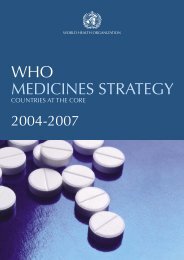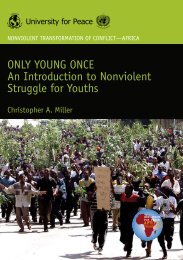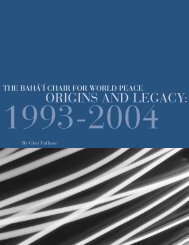environmental degradation as a cause of conflict in - Steiner Graphics
environmental degradation as a cause of conflict in - Steiner Graphics
environmental degradation as a cause of conflict in - Steiner Graphics
Create successful ePaper yourself
Turn your PDF publications into a flip-book with our unique Google optimized e-Paper software.
Native Adm<strong>in</strong>istration, i.e. Tribal leadershipNative adm<strong>in</strong>istration is one <strong>of</strong> the most controversial issues <strong>in</strong> Sudanese politics.Even at its very <strong>in</strong>ception <strong>in</strong> the early 1920s, it w<strong>as</strong> not welcomed by leaders <strong>of</strong> thenationalist movement. It w<strong>as</strong> perceived <strong>as</strong> a government creation that w<strong>as</strong> meantto serve the purposes <strong>of</strong> colonial rule. Follow<strong>in</strong>g the end <strong>of</strong> foreign rule, radicalelements <strong>in</strong> the political parties, <strong>in</strong>clud<strong>in</strong>g elements with<strong>in</strong> the conservative parties,have cont<strong>in</strong>ued to be hostile to native adm<strong>in</strong>istrators (see Bakheit <strong>in</strong> H<strong>as</strong>an1985).Opponents <strong>of</strong> native adm<strong>in</strong>istration are probably justified <strong>in</strong> their attitude to thesystem. The colonial rule really wanted to rely on native adm<strong>in</strong>istrators rather thanon the hawkish leaders <strong>of</strong> the nationalist movement. On several counts they werepreferred to the urban educated elite. For example, they were the ones who hadbeen entrusted with the implementation <strong>of</strong> the so-called Indirect Rule i.e. rule bySudanese natives. Secondly, when a version <strong>of</strong> a local government w<strong>as</strong> founded <strong>in</strong>1937, councils were dom<strong>in</strong>ated by appo<strong>in</strong>ted tribal leaders. Aga<strong>in</strong>, when legislative<strong>in</strong>stitutions were created at the national and regional levels, their members werepredom<strong>in</strong>antly native adm<strong>in</strong>istrators, their families or sympathizers. Some <strong>of</strong> themcont<strong>in</strong>ued to dom<strong>in</strong>ate the political scene <strong>in</strong> the rural are<strong>as</strong> even after the foreignrule came to an end <strong>in</strong> 1956. A resolution w<strong>as</strong> p<strong>as</strong>sed by the October radical government(1965) for the dissolution <strong>of</strong> the system. Then the May Revolution regime,start<strong>in</strong>g 1969, had actually dissolved the system <strong>in</strong> 1970, abolish<strong>in</strong>g its topmostleaders, i.e. the nazirs and other chiefs.One <strong>as</strong>pect <strong>of</strong> native adm<strong>in</strong>istration that h<strong>as</strong> <strong>of</strong>ten been overlooked by its opponentsis its role <strong>in</strong> ma<strong>in</strong>ta<strong>in</strong><strong>in</strong>g law and order <strong>in</strong> the rural are<strong>as</strong>. It is the bestand cheapest <strong>in</strong>stitution <strong>of</strong> governance, when communities are at a traditional orsemi-traditional stage <strong>of</strong> development, particularly <strong>in</strong> a country <strong>as</strong> v<strong>as</strong>t <strong>as</strong> the Sudan.Follow<strong>in</strong>g the weaken<strong>in</strong>g <strong>of</strong> the system by the October caretaker government’sresolution and the actual dissolution <strong>of</strong> the system <strong>in</strong> 1970, lawlessness prevailedamong the rural communities, particularly <strong>in</strong> Darfur. People took the law <strong>in</strong>to theirown hands and started us<strong>in</strong>g force for the settlement <strong>of</strong> disputes. To a large extentthe proliferation <strong>of</strong> tribal and/or ethnic violent <strong>conflict</strong>s <strong>in</strong> the Darfur region maywell be attributed to the weaken<strong>in</strong>g and untimely dissolution <strong>of</strong> the system <strong>of</strong> nativeadm<strong>in</strong>istration.The period, 1916-1956, w<strong>as</strong> notable for peaceful coexistence among groups <strong>in</strong>Darfur. Tribal leaders were not only able to ma<strong>in</strong>ta<strong>in</strong> law and order with<strong>in</strong> theircommunities, but they were also able to establish symbiotic relations among differentethnic groups. They were <strong>in</strong>strumental <strong>in</strong> nurtur<strong>in</strong>g communal <strong>in</strong>stitutions andpractices that contributed to the promotion <strong>of</strong> peaceful coexistence among localgroups (e.g. organis<strong>in</strong>g tribal festivals, tak<strong>in</strong>g wives from other groups, exchang<strong>in</strong>g73











